8 Best Budget DJ Mixers in 2022
DJ mixers come in all sorts of shapes and sizes, with tons of different options covering channels, FX and EQs amongst other common and uncommon mixer functions.
They’re obviously an invaluable component of any mixing setup and they sure take a lot of use and abuse as DJs their twist knobs and push their faders! Of course, this applies not only to the high-end models but also to the best budget DJ mixers.
| Product | Features | |
|---|---|---|
| Allen & Heath Xone:23 | Analogue filter is beautiful; Four inputs (but just two faders); Booth and rec out | PRICING |
| Pioneer DJ DJM-250mkII | Pro faders; USB soundcard; Comes with RekordBox; XLR outputs | PRICING |
| Reloop RMX-33i | Four FX per channel; 3.5mm input; Switchable EQs | PRICING |
| Numark M4 USB | Cheap; 3 channels; USB functionality; Booth and rec outs | PRICING |
| Behringer VMX100USB | Excellent hardware; Cheap; BPM counters useful for some; USB out | PRICING |
| Vonyx STM500BT | Tiny; Great sound quality; Media player | PRICING |
| Behringer NOX101 DJ Mixer | 2 channels; Very strong components; Simple but bulletproof | PRICING |
| Citronic PRO-2b | 2 channels; 5 inputs; Simple with pro components; Classic no-nonsense design | PRICING |
1.Allen & Heath Xone:23
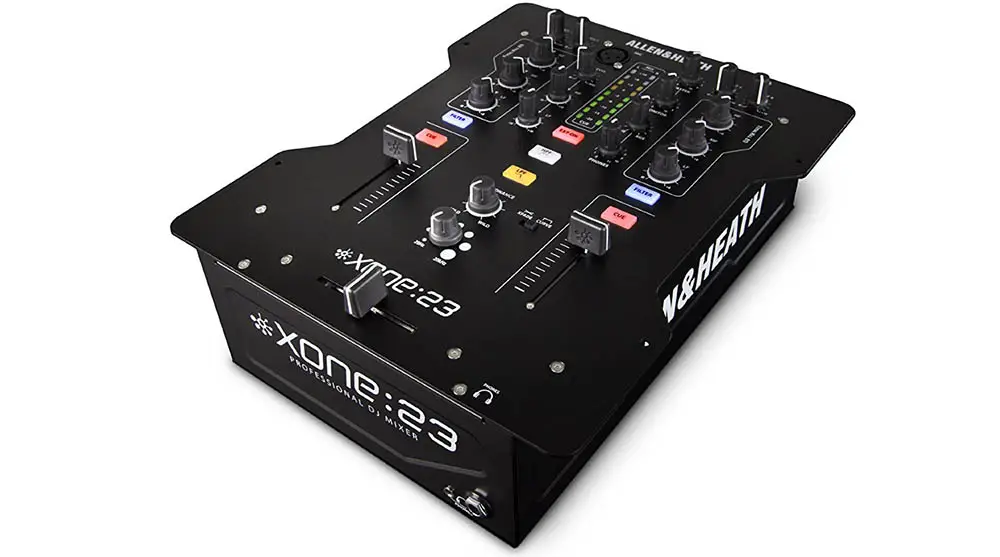
Ok, so this isn’t exactly ‘budget’ but these mixers are absolutely bullet-proof and they will last you a very, very long time. Essentially, this is the cheapest model of one of the most well-known and best-selling mixer lines of all time, the Xones.
Not only does this mixer come with superb pro components and a build quality to match its awesome reputation, but it also works like a dream and is a pure joy to use.
In terms of components and functions, this mixer features full 3-band EQ, an acclaimed analogue filter which works in both high-pass and low-pass mode, enough inputs for 4 sources and both master, record and booth outputs. It even has a mic input with 2-band EQ. It’s rammed with pro components and features, it’s well worth the money if you can go that high.
Pros
- Analogue filter is beautiful
- Four inputs (but just two faders)
- Booth and rec out
- XLR on the main out
Cons
- No FX
2.Pioneer DJ DJM-250mkII
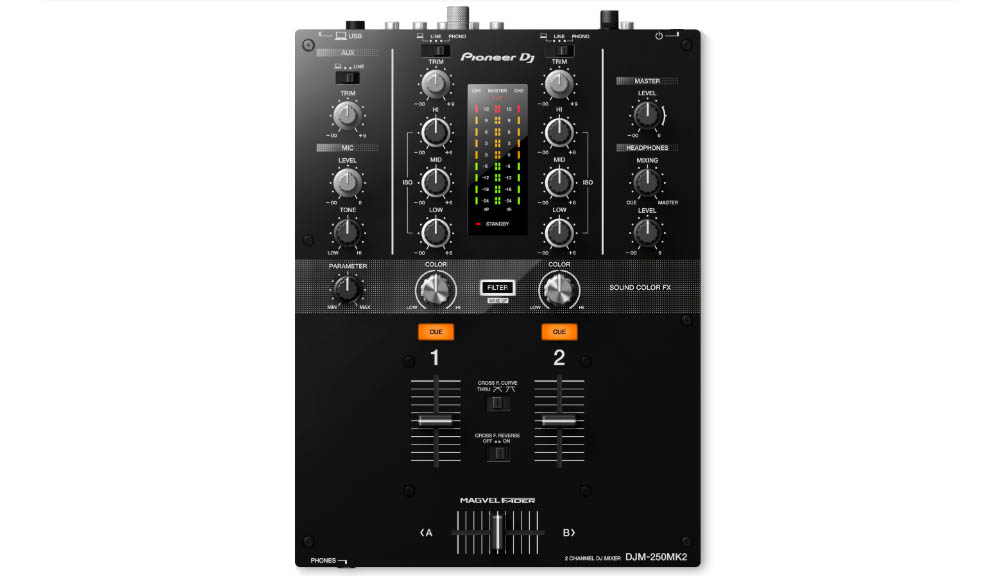
Pioneer’s DJM range is the industry standard, the benchmark, the bar by which other mixers are measured by. They’re hugely successful and have enjoyed top spot for DJs around the world for decades. These mixers combine pro level components, like their top-level faders, with simple but effective functionality all for a reasonable price.
This two channel mixer has both phono and line inputs, Pioneer’s multi-mode filter and a built-in USB soundcard for easy mix recording. In terms of outputs, there are both RCAs and XLR outputs for master/booth outputs. Overall, the USB soundcard is what makes this mixer great value, as it will even allow you to record mixes from DVS or timecode vinyl. Topping it off, this mixer comes with a copy of RekordBox.
Pros
- Pro faders
- USB soundcard
- Comes with RekordBox
- XLR outputs
Cons
- No dedicated booth or rec out
3.Reloop RMX-33i
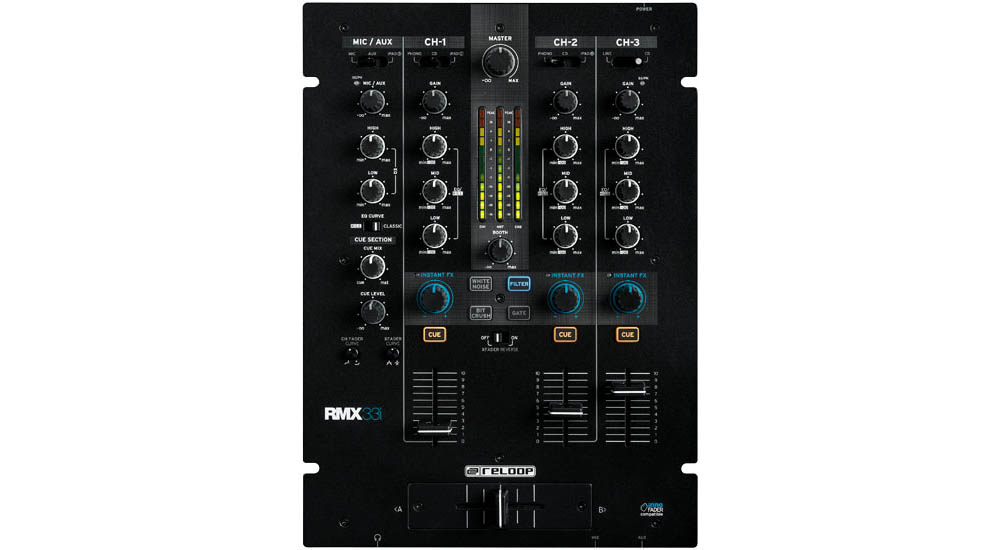
The Reloop RMX-33i is innovative and it fits a niche with its 3 channels and super-powerful FX deck. With inputs to suit both line and phono sources, this mixer is perfect for popular 3-deck setups and each channel is controllable from its own fader – a superb function for a pro mixer. This mixer also has a switchable EQ which allows you to gently EQ tracks or completely ‘kill’ the band.
This mixer has innovative FX which are controllable on each track. This is another highly innovative feature for a mixer of this type and price. Finally, this mixer features a 3.5mm aux input on 2 channels to allow for connection of tablet or smartphone decks.
Pros
- Four FX per channel
- 3.5mm input
- Switchable EQs
Cons
- No USB
4.Numark M4 USB
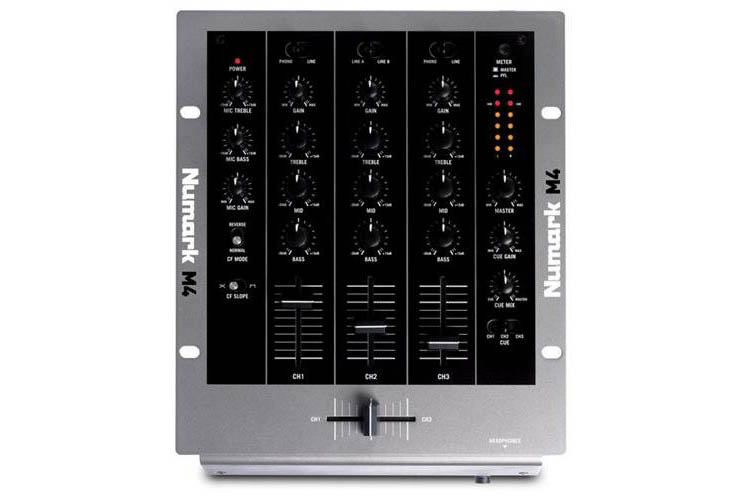
Numark are an old-school brand but they’ve recently forged a name for being the best provider of reasonably priced DJ tech. The M series features several budget options that pack a perfect combination of functionality, durability and performance. The M4 is a 3-channel mixer, the M6 has 4 channels and the M2, which is very cheap, has just 2 channels.
All of the channels on the M4 have phono amps. This mixer and the others in the M USB range also have USB soundcards for easy mix recording. In terms of output, there is both an XLR out and dedicated booth and record outputs.
Pros
- Cheap
- 3 channels
- USB functionality
- Booth and rec outs
Cons
- No FX
5.Behringer VMX100USB 2 Channel DJ Pro Mixer
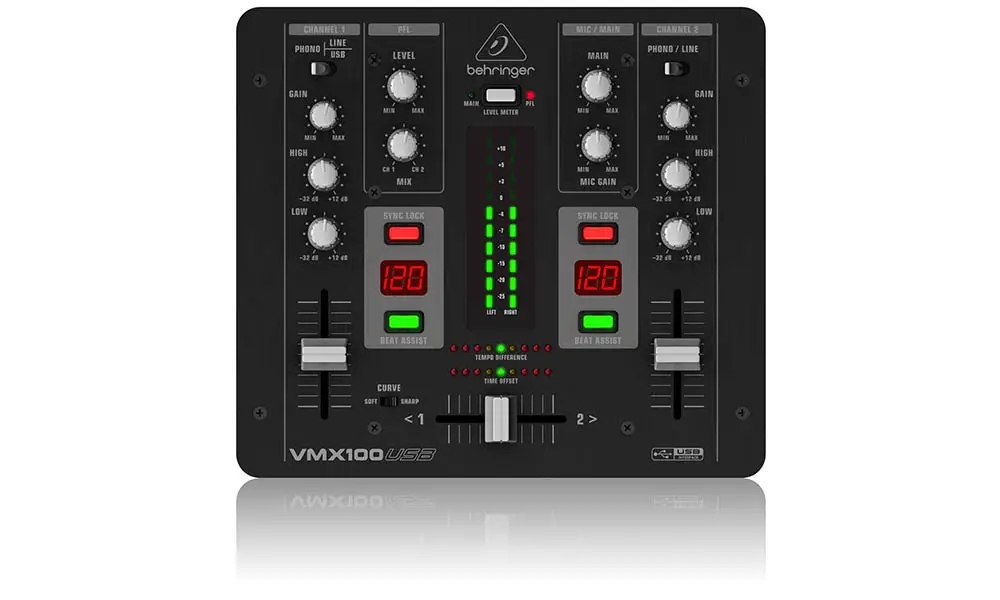
Behringer have a mixed reputation but their incredibly well built cheap DJ mixers have never been in doubt. This very cheap mixer does what it says on the tin and it has some extra features thrown in for good measure, like its BPM counters which are very handy when mixing vinyl.
With professional phono pre-amps and standard mixer features like a 3-band EQ, a record/booth out and quality faders, this mixer packs serious weight for its ultra-slim price-tag. To top it off, it has a USB out for easy mix recording using bundled software
Pros
- Cheap
- BPM counters useful for some
- USB out
Cons
- No XLR output
6.Vonyx STM500BT
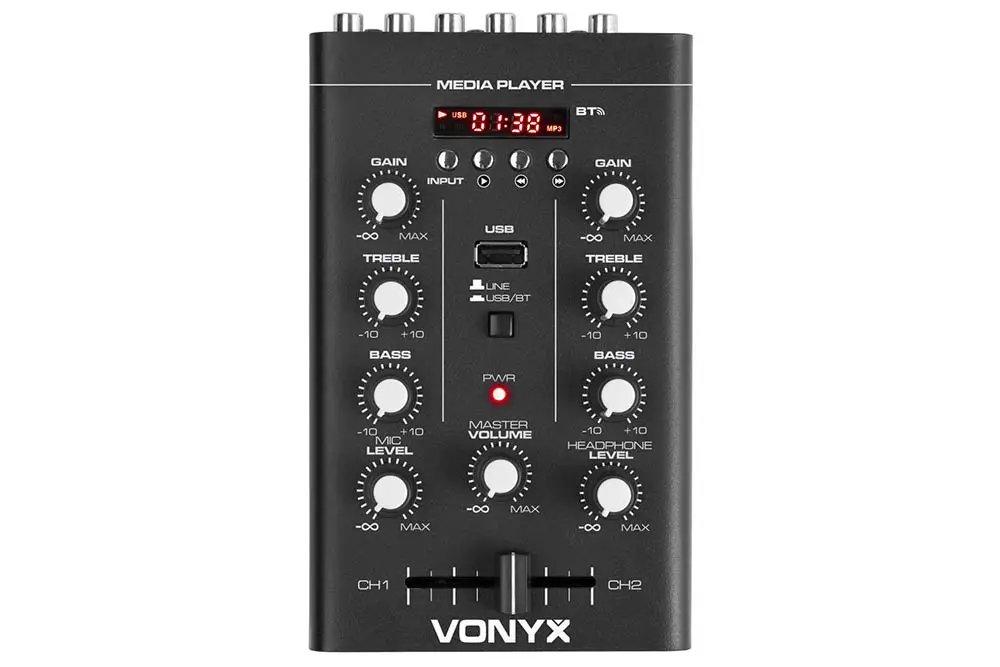
This is a silly cheap DJ mixer which is ultra-portable and very cool with its innovative functionality. It has two very simple RCA line inputs, a master RCA output, a mic input and a headphone output. The channels feature 2-band EQs, highs and lows, and quality faders.
This tiny mixer also has a media player which allows you to play files off a USB stick or even from Bluetooth. It’s an awesome little portable device for mixing and general use.
Pros
- Tiny
- Great sound quality
- Media player
Cons
- Obviously limited by size
7.Behringer NOX101 DJ Mixer
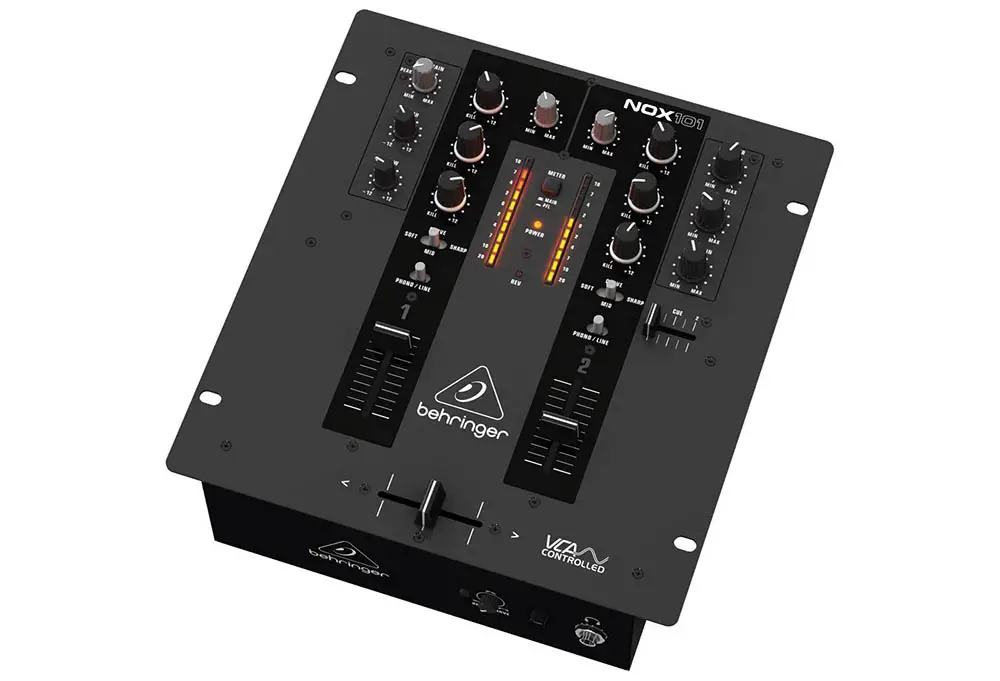
The Behringer NOX series boasts state-of-the-art components which make it suitable for professional use, despite its small size and limited functionality. This is a simple but high-quality mixer, it has a pro crossfader which is proven to work to 500,000 cycles and a XENYX mic pre-amp. Behringer also boasts about its extremely durable chassis, pro phono inputs and well-engineered outputs.
It’s simple but professional in grade, all for a very impressive price.
Pros
- Very strong components
- Simple but bulletproof
Cons
- Too simple for some
8.Citronic PRO-2b 2 Channel DJ Mixer with 5 Inputs
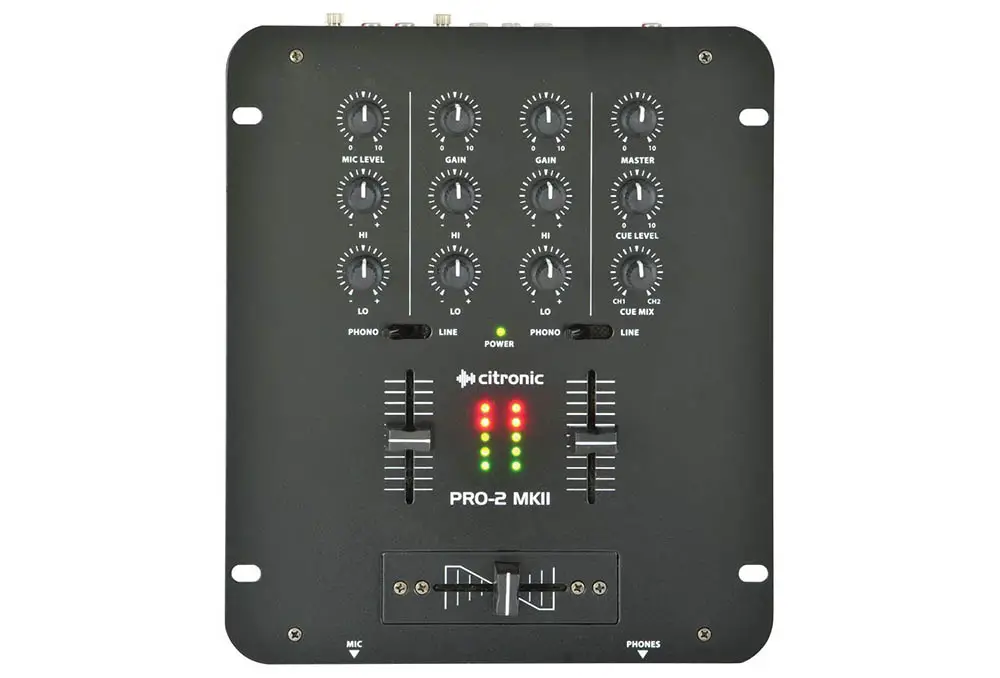
This Citronic mixer is built to a great spec. It’s simple, uncluttered and streamlined for pro use. It has 2 phono and 2 line inputs and a balanced mic input. The faders are what really set this apart though, they’re awesomely durable and are proven to retain smoothness through over 500,000 cycles.
Pros
- Simple with pro components
- Classic no-nonsense design
Cons
- Too simple for some!
The basic principle of a mixer quite simple, you connect inputs (most likely decks or turntables) and outputs (to your speakers) and mix your input signals using EQs and volume faders, FX, etc.
One singular stereo summed signal is output to your speakers, so a mixer really is simply mixing your input signals and outputting them via one ‘mixed’ signal.
Components and Functions of a Standard Mixer
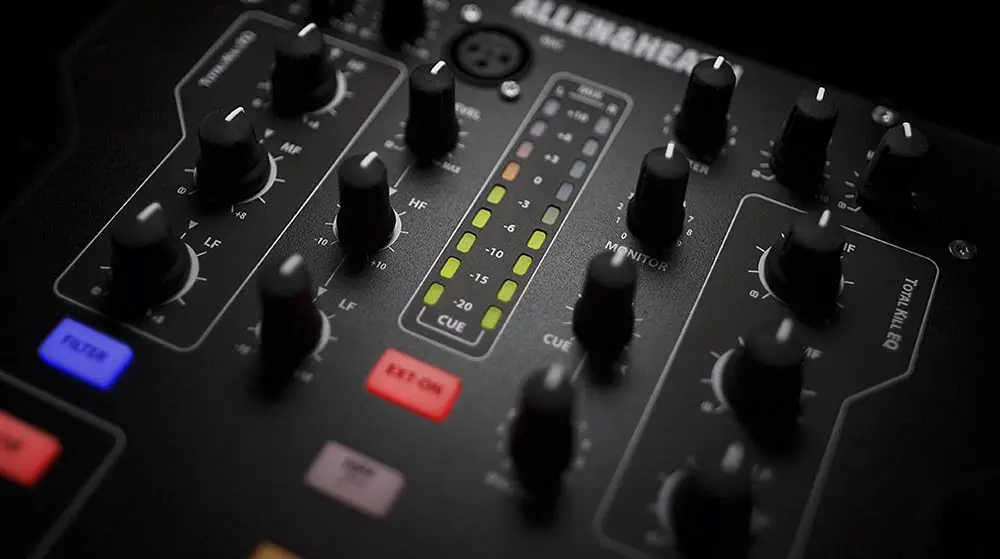
So what is the basic anatomy of the DJ mixer? On the face of it, they’re pretty simple devices but you will find plenty of new and innovative features on modern DJ mixers.
Inputs and Outputs
Every mixer will have an input for each channel. These will usually accept sources at either phono level (for vinyl turntables) or line level (CDJs and other digital devices). Make sure you engage the switch on each channel to select your input type! Outputs are usually RCA or XLR, XLR is more popular and common on newer or more expensive mixers. As well as your master output, mixers may have a rec out, for outputting to a recording device, and a booth out, for outputting to your monitor speakers.
Faders
Every mixer has faders. Each channel will have its own fader for volume control and there will be a crossfader mounted in the centre of the mixer to control the blend between your channels. The fader is far more convenient for this job when compared to the knobs you find on gains and EQs.
Gain
Gain is separate to the fader and allows you to adjust your input’s volume to a level suitable to your sound system. The gains are usually left unchanged through a set but you may have to turn them up for particularly quiet tracks.
EQ and Filters
The vast, vast majority of mixers have 3 EQs, high, mid and low. Some mixers do have 4, though, to allow for greater control over EQ balance. Mixers also often contain filters which work similarly to EQs – they usually either gradually low-pass the channel or high-pass it.
Cue Buttons
Mixers have a ‘cue’ button which you press to make the track audible in your headphones. You can also ‘cue’ the master output so you can hear what is being outputted to your speaker system.
FX
Many mixers have built-in FX banks. These are typically operable from an FX bank where you can control FX type, sync and other parameters.
Pro DJ mixers are often very expensive and the biggest and most impressive mixers from the most famous brands like Allen and Heath, Rane, Native Instruments and Pioneer can knock a rather large dent in your bank account.
However, it’s entirely possible to grab yourself a budget mixer from these manufacturers and others. Smaller mixers from the big brands won’t necessarily set you back huge amounts but you can spend less than £150 by wandering outside the realms of the big pro DJ brands.
Summary
There’s a good mix here ranging from Pioneer, Reloop and Allen and Heath’s cheapest but thoroughly pro-level mixers to budget providers Numark and Behringer. Mixers don’t have to set you back thousands, the standard is very high now and the pressure is on manufacturers to put out awesome equipment at affordable prices.
If you can afford a pro mixer then you should go for it. They’ll last you years and years and with spares and repairs easy to find and affordable, you’ll always be able to keep it going, no matter what goes wrong.
Happy mixing!
You may also like: